Friday Night Unplugged #11: Descent: Journeys in the Dark
- Updated: 25th Jan, 2013
Last month we talked about Super Dungeon Explore and its player vs player gameplay, with one player taking on the role of the Consul and the others taking on the Heroes. This week’s game is Descent: Journeys in the Dark, Second Edition and it’s just like that; one player controls the overlord and the others control the heroes but with one key difference. When played with full knowledge of rules effects, the Overlord, unlike the Consul in SDE, is more than capable of winning.
The Basics
Descent: Journeys in the Dark is a PvP RPG board game. A game of Descent plays out on a map constructed from a large range of tiles. Depending on the adventure being played this could be anything from villages to temples or cold dungeons. Heroes move in from the entrance and make their way around the map killing monsters, saving villagers, hunting treasure or whatever objective the adventure in play details. The Overlord on the other hand has his own objectives; nefarious, evil objectives.
Each player starts with a Hero card showing their character’s stats, some basic skills and equipment. The Overlord gets to draw a hand of trap and event cards they can play in an attempt to gain some advantage over the Heroes.
- Heroes start. Players in control of heroes must decide on an order for that turn and activate each hero in that order.
- An activated hero can perform two actions only in a turn; moving up to their speed, opening doors, searching for treasure at a search point, attacking or resting.
- Then the Overlord activates his monsters one group at a time and can activate figures in that group in any order. They can perform same actions as heroes except for treasure-searching and rest.
There are a few other things to note:
- Skills cost fatigue. Once each hero reaches their maximum, the only action they can complete is resting to recover.
- Heroes can gain health by rolling special surge symbols when attacking or using items.
- Attacks and defence are made by rolling the appropriate dice as listed on the equipped weapon, monster or hero.
- In a similar manner to last week’s Edge of the Empire skill check, defence icons block attack icons. If any attack icons remain the monster/hero takes that much damage.
Time To Play!
As usual Fi and Josh are joining me as heroes for this run through and already have characters set up through the campaign rules. Fi is controlling a spellspeaker (mage) and wildmaster (ranger), Josh controls a tank-like paladin and a suitably overpowered runemaster thanks to some lucky search draws in the previous game.
We’re about to start the first encounter of a section of the story set in Daerintown. It’s late in the evening and the Overlord has sent his minions to attack Castle Daerion. There is chance to warn them though, if the heroes can light all 4 beacons to warn the castle of approaching danger before the monsters kill all the villagers. As the Overlord I get to pick 2 open groups for this encounter as opposed to the set groups that others have. I chose a pack of barghest wolves for speed and numbers and a duo of elementals for sheer brute force. Placing them on the required start points, we were ready to go.
Round 1: The group rushes into the first room location on the map where they run into a waiting pack of barghest. A few well placed attacks later and they manage to take down one of the attacking barghest and severely wound a few of the others. It’s Fi’s turn to move the villagers so she tries to move them further away from the current monster locations.
It’s now time for the Overlord round. Starting with the elementals I make my move towards the closest building and the first villager. They are slow so can’t move far but thanks to an Overlord card granting extra movement I can make it a little further into the map. The barghest manage to make a few small dents in the heroes but thanks to some lucky defence rolls, the heroes still stand.
Round 2: Despite me spawning a new barghest behind the heroes, in one fell swoop they manage to clear the entire room in a mix of failed defence die and some great skill usage from the Paladin’s beatstick. They even manage to light one of the bonfires. With little to do I spawn a new monster behind them and get to work with the elementals. Comboing with 4 of the Overlord’s event cards, I succeed in moving through half the map and taking down 2 of the villagers with another severely wounded. 2 down, 2 to go.
Round 3: The heroes start with only the one monster near them so Fi takes the chance to move her spellspeaker and wildmaster into the large clearing in the centre of the map. Rushing straight for the bonfire she succeeds in lighting it. We’re each 2 for 2 by now but she’s dangerously close to the elementals.
Josh fends off the barghest behind him with the paladin and stays to defend the nearby villagers with the runemaster. It’s back to my turn and I rush at the nearby spellspeaker with the elementals after spawning a second barghest next to the last round’s creature.
I sacrifice my elementals thanks to two Overlord cards I drew the previous round and in return I get 4 extra attacks. The spellspeaker survives but in an explosive attack the wildmaster and one of the nearby villagers falls. The barghest attempt to take down a hero but fail, neither advancing nor falling back they stay their ground.
Round 4: The last round is a last ditch attempt to defend the remaining villager. Fi’s spellspeaker retreats to go block the barghest at the entrance. If they can’t get past, chances are the villager will survive long enough that the heroes can rush through and light the bonfires. Despite some valiant efforts they fail to take down either barghest before the end of their turn.
On my go, I decide not to spawn any more monsters as they will spawn too far away to be of use. With 2 failed defence rolls the first barghest takes down the spellspeaker that was blocking its way. The second rushes through and straight for the remaining villager. I spend one more Overlord card to give it 2 extra attacks. They both land without being blocked and the last villager dies.
Result: The Heroes lose this encounter. They won’t have any support in defence of Castle Daerion during their next session.
The Stats
Descent is a game for 2-5 players. The average playtime (depending on whether you do both parts of an encounter) is around 2 hours. It’s also in my favourite category of games – a miniatures game. Descent comes with around 39 figures including monsters and heroes; everything from sea creatures to dragons and zombies can be found in the box. All of them are of high detail and quality.
The miniatures aren’t the only thing that will withstand numerous play sessions. It’s clear Descent is designed to be sturdy as the tiles themselves are very thick, rigid pieces. The joins are solid where they are designed to interlock and the art on them is amazing. Handily, they’re all numbered and easy to find when putting together the maps.
Alongside the rule book there is also a 43 page adventure guide. Designed to be played in campaign mode, this details all the various encounters and win conditions. There’s nothing stopping you from picking one at random if you just want to test things out. It is a Fantasy Flight game and, as with most FF games, there are lots and lots and lots of tokens, cards, dice, tiles and figures. This is great, if a little daunting when you first set it out. After a few games however, setup time drops from 15 minutes to closer to 5. You know what you need and where it is.
What We Thought
Where Super Dungeon Explore is a light hearted kill counter that wants to be a video game when it grows up, Descent is cold, jaded, brutal and at the same time so much more colourful.
Firstly I’d like to emphasise that the campaign mode is amazing. While new to the Second Edition the campaign option isn’t completely new to the Descent series as a whole. One of the first edition campaigns included an epic 200 hour+ campaign titled Road to Legend. Thankfully this is nowhere near that scale but it is still a large campaign that take a good few months of casual play to complete, maybe fewer if you play more often than once a week.
It’s not just the length of the campaign that’s impressive. The variety of adventures is a breath of fresh air to a veteran tabletop gamer and a big pull for new players, as we discovered. Sometimes you’re trying to save villagers, other times you’re hosting rescue missions in dungeons or searching for treasure deep in a forest and that’s something we love having in a tabletop game.
Of course there are a few gripes. The rules are vague in places and some of the encounters are a little difficult to believe or heavily stacked in either side’s favour. The balancing is a little off but I’ve yet to see a competitive PvP game that isn’t somewhere. Shut Up and Sit Down reviewed the original Descent which they criticised for containing “a lot of bullshit”. Back then, there were many pages of errata and it was a little broken. However the second edition is streamlined, smoothed out and doesn’t contain any of said bullshit.
Descent is essentially Dark Souls: The Board Game. Or perhaps Dark Souls is more like Descent: The Video Game. You see, as the heroes your characters will die multiple times each encounter. As the Overlord, you will lose monsters and you will sometimes find it a grind to complete encounters. The game’s mechanics are sometimes confusing, the abilities don’t often make sense and weapons you find aren’t always useful.
Like Dark Souls, when Descent clicks it really clicks. It’s a whirring human-driven machine with so much depth and potential it’s difficult for me not to recommend it to anyone with a love for tabletop games.
Really Descent: Journeys in the Dark – Second Edition is the gamer’s game, clichéd as it sounds. If you like dice rolling, it’s got that. If you like miniatures, it’s got them too. If you yearn for epic campaigns and dastardly dragons without all the hassle of stat sheets and +4 upgrades and calculating rolls then Descent is for you.
If you want a game that will continue to grow, a game that you create your own content for (thanks to the newly launched map creator) and will always have something new to offer you and your group, Descent is it. It’s also well worth every penny of the £52 price tag over at Amazon. What are you waiting for? Go get it.
Next Week:
Next week on Friday Night Unplugged we’re breaking the format. Rather than our usual semi-reviews we’re going to be celebrating the release of the latest set from what is probably the world’s most popular collectible card game. Of course I’m talking about Magic: The Gathering and I’m going to be explaining why this new set is the perfect time to start playing and what’s the best way to do so.

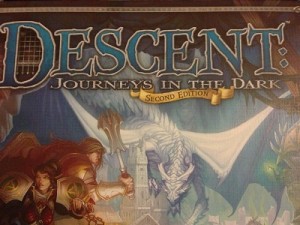
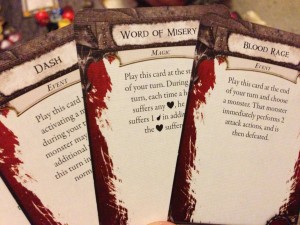
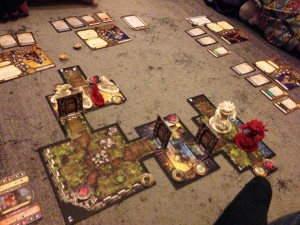
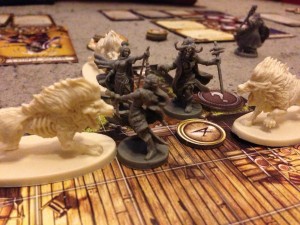
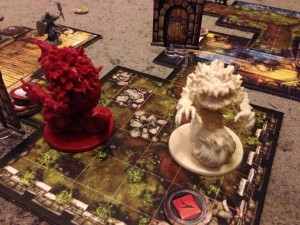
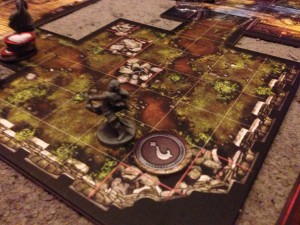
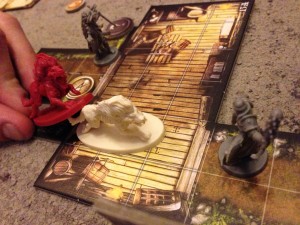
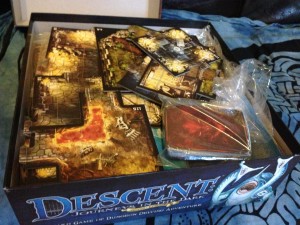
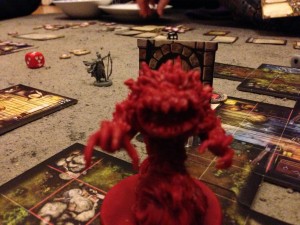
Follow Us!